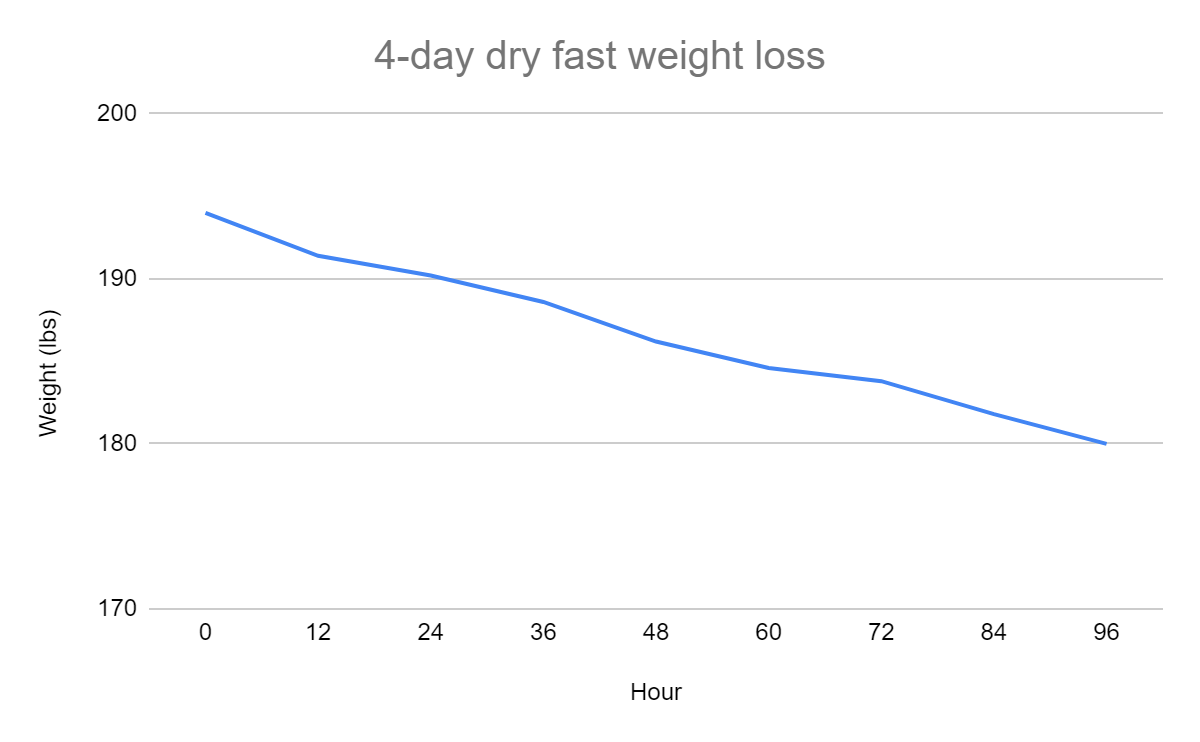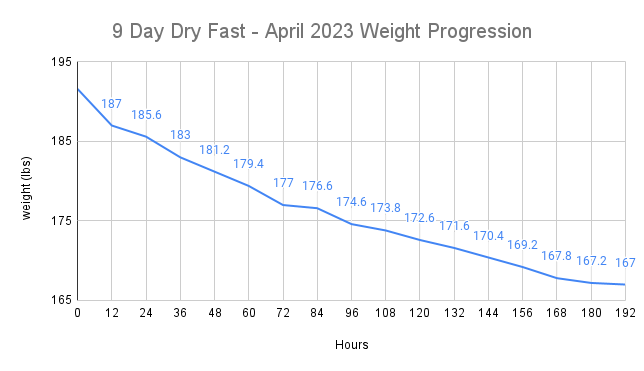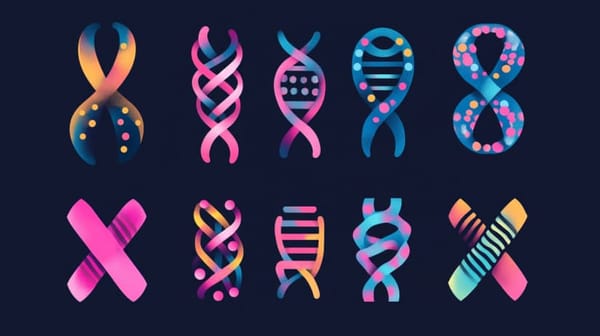Today we're going to discuss the following topics and questions about weight loss and dry fasting. How does dry fasting impact weight loss? I'll give you approximate numbers and talk about the correlation between ketones and fat loss. We'll talk about dry fasting and how it accelerates weight loss compared to other types of fasting and also how it affects our metabolic rate aka "our metabolism". We'll also touch on dry fasting benefits for people who are obese vs. lean. as well as what kind of signs and symptoms to keep an eye on when it comes to fat loss. We'll finish off on how to maintain the fat loss after the dry fast and also on the ideal timing windows for losing weight.
VideoDry fasting typically results in rapid weight loss, although much of it is water weight initially. The beauty of dry fasting when it comes to fat loss is that a dry fast will burn more fat compared to muscle. This is a hidden gem that people are unaware of. Of course, fasting is never the best way to keep weight off, since it will rebound unless you change your diet and activity levels afterward. Still, compared to water fasting, dry fasting will help you lose much LESS muscle and MORE fat in the same amount of time.
How does dry fasting impact weight loss?
You can lose approximately 2.2 pounds per day dry fasting. This varies person to person, but establishing 2.2 pounds as a solid baseline usually works. You need to keep in mind that the first few days will include a lot of water loss. In fact, you can expect to lose anywhere between 5-10 pounds during those first hours. Yes, you can have a drastic weight swing in the first 36 hours when you lose your glycogen store. Once you get through the initial water loss, you start losing approximately 2.2 pounds per day. Of this, you approximately lose 0.3 lbs of muscle and 0.9 lbs of fat. If we make some assumptions about glycogen depletion and exercise, fat starts to get burned around 12 hours of not eating. The fat loss ramps up for another 24 hours and starts to peak once you are in deeper ketosis. Do you want to know when your body gets to that deeper ketosis? This can easily be measured by urine test strips. Ketones are created from fatty acids which are created from fat cells. The reason high ketones indicate high-fat loss is that fat needs to be broken down for ketones to be created. Picture fat cells being broken down. You get a lot of fatty acids which get converted to ketones. You can also track this with an even stronger measurement of ketosis by also tracking your blood glucose levels. Blood glucose (mmol) divided by ketone levels (mmol) gives you the GKI index. Google it if you're interested. Without tracking ketones, and without extended fasting you might get trapped in a circular game of glycogen getting barely used up and then refilled every time you eat. In this case, you'd never really get to the fat burn your're looking for.

Does dry fasting accelerate weight loss compared to other types of fasting?
Yes, fat loss is much more pronounced when dry fasting compared to water fasting. Dry fasting requires fat breakdown to provide the necessary water during hypertonic stress. That's the cellular stress you get from dehydration. Also, you can notice higher ketone production much quicker on a dry fast. You can also notice that the acidotic crisis arrives on day 3 of a dry fast as opposed to day 7 of a water fast. That's more than twice as fast. There's even a study on zebra finches that shows less muscle loss, more fat loss, and similar hydration levels when dry fasting vs. water fasting. So, if you're planning on doing the most efficient fasts, you'd definitely want to look into dry fasting. However, rehydrating in between fasts is critical, and you should not treat dry fasting as a daily lifestyle. It can get dangerous.

What kind of dry fasting windows are best for fast fat loss?
If you're trying to build a weight loss routine that is not too crazy but offers powerful fat loss, you want to look into 36-hour dry fasts once a week. This is a powerful routine that will absolutely change you into a new person over a few months. In a year you won't recognize yourself. Dry fasting builds a new appreciation for both food and water and you'll realize you're a more healthy person that makes healthier choices over time. To really power up your fat loss look into MCT oils at the start of your fast.
36-hour fat loss dry fasting routine - Balanced
Here's an example of a routine preparation, dry fast, and refeed for a 36-hour style dry fast. This is a very balanced approach that will help tremendously in the long run for fat loss and body recomposition.
| Phase | Time (Hours) | Action/Activity | Notes/Recommendations |
|---|---|---|---|
| Prep | -6 to 0 | Hydration | Drink plenty of water to hydrate well before the dry fast. |
| Nutrient-rich Meal | Consume a balanced meal with proteins, fats, and carbs. | ||
| Relaxation & Mental Prep | Consider meditation or light stretching. | ||
| Dry Fast | 0 to 36 | No Food, No Water | Engage in light activities; avoid strenuous exercises. |
| Check-in on Physical & Mental State | Monitor how you feel. If unwell, consider breaking the fast. | ||
| Sleep | Ensure you get a good night's sleep. | ||
| Refeed | 36 to 40 | Start with Small Amounts of Water | Sip slowly. |
| Introduce Light, Easily Digestible Foods (e.g., bone broth, steamed vegetables) | Avoid heavy, fatty, or very sugary foods initially. | ||
| 40 to 48 | Progress to More Solid Foods | Listen to your body's cues. | |
| Continue Hydration | Keep drinking water regularly. | ||
| Reflect on Experience | Note any particular benefits or challenges you faced. |
36-hour fat loss dry fasting routine - Aggressive
If you would like to jump into something much more aggressive for fat loss, here's a bit of an advanced routine for 36-hour dry fasts. If done correctly you can expect double to triple the speed of fat loss. This is catered to someone who is more driven and likes to push their limits. It is still a step behind death fasting, but that is something that should only be done once you are very comfortable with dry fasting. Once you reach hour 48 you should be able to transition back to your regular diet. If you can repeat this once a week you will start seeing a massive transformation. Note, this should not be done if you are sick and looking to heal a health issue.
| Phase | Time (Hours) | Action/Activity | Notes/Recommendations |
|---|---|---|---|
| Prep | -6 to 0 | Intense Workout (HIIT/Cardio/Strength training) | Aim to deplete glycogen reserves. |
| Drink Ketone Salts or MCT Oil | Helps initiate ketosis faster. | ||
| Hydration | Drink plenty of water with added electrolytes. | ||
| High-fat, Moderate Protein, Low-carb Meal | Push the body further into ketosis. | ||
| Relaxation & Mental Prep | Consider meditation or light stretching. | ||
| Dry Fast | 0 to 12 | Light Exercise (Yoga) | Stay mindful of energy levels. |
| 12 to 24 | Low-intensity Activity (Walking or Light Cycling) | Keep it gentle; remember, you're fasting. | |
| 24 to 36 | No strenuous Activity | Allow your body to rest and tap into its fat reserves. | |
| Regularly Monitor Physical & Mental State | If feeling unwell, consider breaking the fast. | ||
| Refeed | 36 to 37 | Start with Small Amounts of Coconut Water | Rehydrate and restore electrolytes without causing edema. |
| 37 to 38 | Light, Easily Digestible Ketogenic Foods (e.g., avocado, macadamia nuts, bone broth) | Keep it low-carb to stay in ketosis. | |
| 38 to 40 | Progress to Denser Ketogenic Foods (e.g., fatty cuts of meat, eggs, cheese) | Follow your hunger cues and eat until satiated. | |
| 40 to 48 | Continue with Regular Ketogenic Diet | Maintain ketosis and monitor how you feel. | |
| Reflect on Experience | Note the benefits, challenges, and areas for improvement. |
If you eventually want to progress to doing 72-hour and longer dry fasts, you will need to drastically alter this routine. One of the main changes will be to start the refeed with strictly water, and to make sure you don't start the refeed with fatty foods. You can view more health-based routines by looking at the scorch protocol for dry fasting and autoimmune disease.
Is dry fasting better for obese people to lose weight?
Yes, dry fasting is an ideal tool for obese people. Since your body is already more adapted to getting energy from fat moreso than from proteins, being obese means that you have an advantage. Fat cells produce the most metabolic water when broken down, so you don't have to worry about dangers that come from having too little fat.

Looking at this graph here, you can also see that as you lose weight, your body starts to use more energy from protein. It makes sense that fasting is a powerful tool for weight loss for obese people, however fasting for weight loss when already skinny and muscular is not always the best choice. Of course, dry fasting plays in its own arena, and may actually be something to consider when trying to get absolutely shredded. The resulting increase in growth hormone after an intense death fast is pretty serious. There's a reason boxers and UFC fighters use a technique called death fasting to make lower weight on their next weigh-in. The next day they drink water and gain most of it back. The caveat may be that it will slow down your metabolism significantly if it has to burn more protein since that doesn't provide as much water as a molecule of fat. So remember, we don't have enough data to really optimize dry fasting for muscle building, but we can logically assume it is a good solution for obese and unhealthy individuals if they will be able to control their preparation and refeed correctly.
Does dry fasting impact muscle mass, or does it primarily target fat?
So let's take it back to a study done on zebra finches and its correlation to dry fasting. When zebra finch birds fast, their body reacts differently based on their access to water. In a study, three groups were observed: birds with access to both food and water, birds without food but with water, and birds without both. It was expected, based on past research, that birds without food and birds without both food and water would use more proteins to maintain their water balance. However, the study found that birds without access to water relied more on burning fat, which actually resulted in them being more hydrated than those that were water fasting. Isn't that crazy? You've probably heard of people saying that dry fasting is actually safer and healthier than water fasting. You were probably like "Pfft, yeah right!" But, it starts to make sense when you take the idea of electrolytes and hydration into the equation. You can keep pounding the body with water, but if it doesn't have the required minerals to hold that water, it will simply go through them, and possibly take even more minerals with it. With dry fasting it seems that the body gets a better grasp on maintaining its electrolyte balance, holding on to minerals, including salt, much better.

Another thing that impacts muscle loss while on a dry fast exists between athletic and obese people. Athletic individuals increase their ketone production much quicker than obese ones. If you're lean and athletic your body is already used to burning a mix of protein and fat when glucose stores dip down. So it makes sense that in a fasted state, a lean person will jump into ketosis faster. This is even more accelerated on a dry fast. Of course, the lean individual needs to have enough stored fat for this. Once the lean individual runs out of fat, we're in dangerous territory. This is also one of the reasons why light exercise is recommended to deplete glycogen faster and spare even more muscle. Heavy exercise, on the other hand, is never recommended on a dry fast because it has the reverse effect. It dehydrates you too quickly, it disrupts the balance, and it also creates a big energy shortage which must be replaced by burning protein, especially before the body gets fully fat-adapted.
The body also still requires glucose, even when fully fat-adapted. About 30% of your brain, red blood cells, and a few other organs need glucose to function. They can't run on ketones. The body does this through gluconeogenesis. Gluconeogenesis has limited rates, which means there's a cap to how much glucose it can create per minute. So if the energy requirement is too large for the glycerol to meet the glucose needs, then the body will also activate the protein glucose pathways. Once again, this is a reason why you should maintain steady and light exercise, but not overdo it during a dry fast.
Are there specific signs during a dry fast that indicate the body is in a fat-burning state?
Yes, you can quite easily track whether the body is in a fat-burning state on a dry fast by monitoring ketone levels, blood sugar levels, urine specific gravity, and keeping an eye out for certain symptoms like the dry fasting heat. When it comes to dry fasting you should be tracking your data. It's actually quite simple, especially if you follow my guide on data tracking during a dry fast. If I guide someone on a fast and we track their data, we find some really interesting things on top of figuring out what the person's baselines are and how well their body is able to transition to fat-burning and deeper autophagy. This allows for more personalized and effective protocols.
Most people live their lives in a low ketone state. If you were to test your urine for ketones it would come up mostly negative and sometimes you might even get some trace ketones. If you're exercising a lot and depleting your glycogen, you'll have more ketones than someone who is living a more sedentary life. It starts to get interesting when someone is doing a low-carb diet like a ketogenic diet, a zero-carb diet, or a carnivore diet. These diets focus on keeping your glycogen levels pretty low which in turn makes your body look to fat and proteins for its energy requirements. Because these diets help you become fat-adapted, it means that you'll be burning higher levels of fat which in turn will translate to higher levels of ketone production. It's pretty common to see ketone levels for these people come up around 1-2 mmol on breath or urine readings. Once you start extended fasting you'll notice ketone levels skyrocket. And boy oh boy do they go up. There's nothing that skyrockets ketone levels faster than dry fasting. Why? Because dry fasting adds a new stressor called hypertonic stress. This directly relates to dehydration levels. Your body needs water, and there's no better way to make internal water than to burn fat cells.

The specific signs you can keep an eye out for that indicate that your body is in a fat-burning state are:
- Increased Thirst and Decreased Urine Output: Dry fasting slowly leads to dehydration. As the body uses up its glycogen stores, it also expels water, which results in increased thirst.
- Fruity/Acetone Breath: A fruity, acetone-like smell on the breath is a common side effect of ketosis. A lot of people use this as a physical measurement. Once you've gone through it a few times on a dry fast, it really starts to become obvious. Sometimes this symptom can become a bit of a metallic taste in the mouth instead of the fruity/acetone one.
- Increased Energy and Mental Clarity: After an initial period of fatigue (often referred to as the "keto flu"), many people report a significant boost in energy levels and clearer thinking once they're firmly in ketosis.
- Decreased Hunger: Ketones have an appetite-suppressing effect, which can lead to a reduced feeling of hunger. The beauty of a dry fast is that you enter ketosis much faster so that hunger feeling goes away quicker than on a water fast. You also fight both hunger and thirst, where the thirst beats out the hunger 9/10 times.
- Keto Flu: The keto flu is a side effect of entering ketosis. A lot of people confuse themselves when they feel horrible on the first few days of a fast. They start to think that they're dying from not eating, detoxing, or a parasite die-off. When in fact, they're simply experiencing keto flu symptoms. The keto flu can be greatly exaggerated by also going through a caffeine or nicotine withdrawal, so remember that.
Does dry fasting target stubborn fat areas, like belly fat or thigh fat?
A person with a Body Mass Index of 20 (that means borderline underweight) will derive almost 40% of energy needs during prolonged fasting from protein. Compare that to a person with a Body Mass Index of 50 (morbidly obese) who may only derive 5% of energy from protein stores. Once again this demonstrates our body’s inherent ability to survive. If we have stores of body fat, we use them. If we don’t have those stores, we don’t.
If you have a BMI of 30 and up, your fat will fly off on a dry fast. A common strategy to do this correctly is to get into a low-carb diet so that your body gets through your keto flu first. Once that's conquered, you can start thinking about fasting. There's also tricks like using mct oil right before you start your fast.
Lean people will transition into ketosis faster, so if you are pretty athletic and lean, your stubborn fat areas will be aggressively targeted during a dry fast, especially if you get into the longer dry fast stages. Remember that the first day does a lot, especially if you use up your glycogen stores, but if you're one of the unlucky ones where your body really prefers protein breakdown in the first few days, then you'll need to push into the dehydration stages where the body will have no other option than to burn extra fat for water and energy.
If you're very lean already without stubborn fat areas, you should definitely be wary of fasting for extended periods of time. Once you run out of fat, your body is forced to run on proteins. This can get dangerous once it goes so low that the body starts to use organ muscles for food. You should never get to this stage. It's always helpful to get professional help to correctly measure your fat stores if you are very lean and thinking of fasting.
How to maintain fat loss results after completing a dry fast?
A lot depends on your metabolic rate when it comes to maintaining fat loss results after a dry fast. You need to make sure you're able to restart your metabolism and get your metabolic rate back to pre-fast levels. To do this you need to make sure that your refeed is being done correctly. Having consulted and talked with so many people over the last couple years, it's mind-blowing how nearly every single person cheats on their refeed. If this happens to you, don't beat yourself up. I know I used to really get myself down thinking I was a failure when I over-ate multiple times. But let's not pretend that there's nothing wrong with it. You will impact your metabolism and fat loss. If you overeat on the refeed too quickly, you will gain fat back much quicker, since your metabolic rate will be slower and your body will be primed for building fat. Think about it. Your body has to slow its metabolism because it is preparing for a period of starvation. If your body is in this primed state, giving it a good amount of food will trigger fat-converting mechanisms. I mean wouldn't you want your body to quickly build up as much fat as possible if you were going into a starvation style situation?


I have some data here from a recent 5-day dry fast. You can see that I entered ketosis around the 48-hour mark because I had a carb-heavy meal before the start of the fast. You can also see the importance of the refeed. A four-day dry fast seemed to have gotten rid of approximately 5 pounds of fat when refeeding correctly.
How does dry fasting affect metabolic rate?
Here's where it gets tricky. There's more to keeping off the weight than just dry fasting. You've probably all heard the term rebound weight. Or rebounding after any sort of diet. It's kind of similar with fasting and any caloric restrictions. In fact, most people that restrict calories, always seem to gain their weight back once they go back to eating at TDEE - Total daily energy expenditure. To calculate your TDEE you can use many online calculators that estimate your BMR - Basal Metabolic Rate, TEF - Thermic effect of food, TEA - Thermic Effect of Activity, and NEAT - Non-exercise activity thermogenesis.

The reason I say that it gets tricky is that your BMR changes based on many many factors. Dry fasting and any sort of fasting, just like any caloric restriction slows down your metabolism. So it becomes a bit of a cat-and-mouse game where you are constantly trying to outwit your BMR. You need to understand that increasing your calories will signal to the body and its mitochondria that food is plentiful and that they can increase the BMR. The more you eat, the more of a thermic effect you also produce as the food is digested. But don't forget that eating too much too quickly will still signal fat storage. It's a delicate balance.
In fact, in a healthy and active body, if you carefully increase the amount you eat, you won't gain weight too quickly. You can rely on the dry fast to help slowly recomp your body and your hormones to help you increase your BMR, but you'll need to do it methodically. The answer lies in not overeating, and not undereating. It revolves around mastering a gradual upswing in calories while maintaining a proper digestible refeed. It also relies on incorporating a gradual uptick in exercise. Yes, exercise is key to a healthy life.
Thanks for reading and listening. Dry fasting is a great tool for fat loss, but by itself, it's not really optimal. It's not optimal because you will regain the fat quite quickly if you do not make lifestyle changes. The beauty of it is that you can develop a much healthier relationship to food when you dry fast. Until next time. Good luck on your dry fasting journey.







